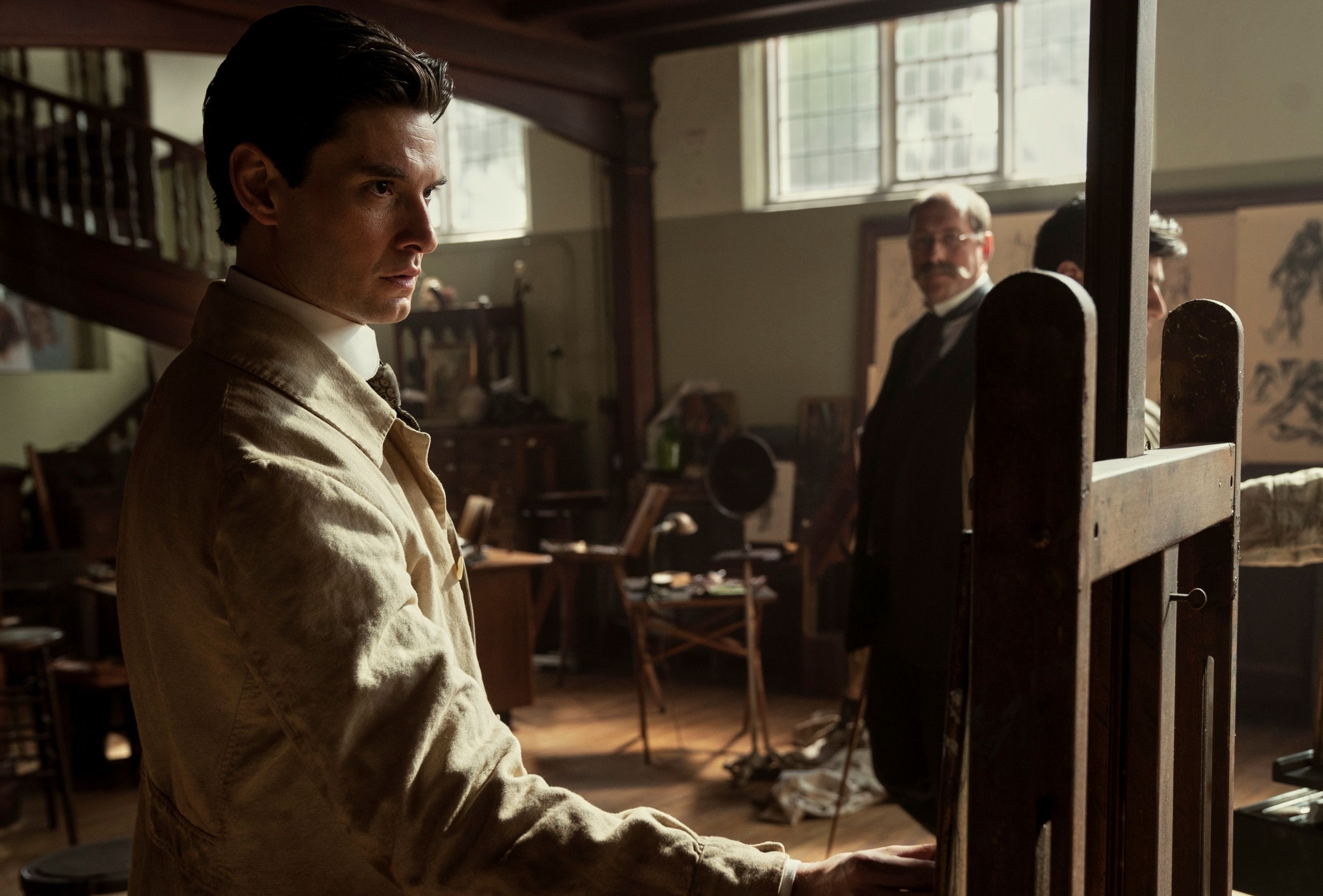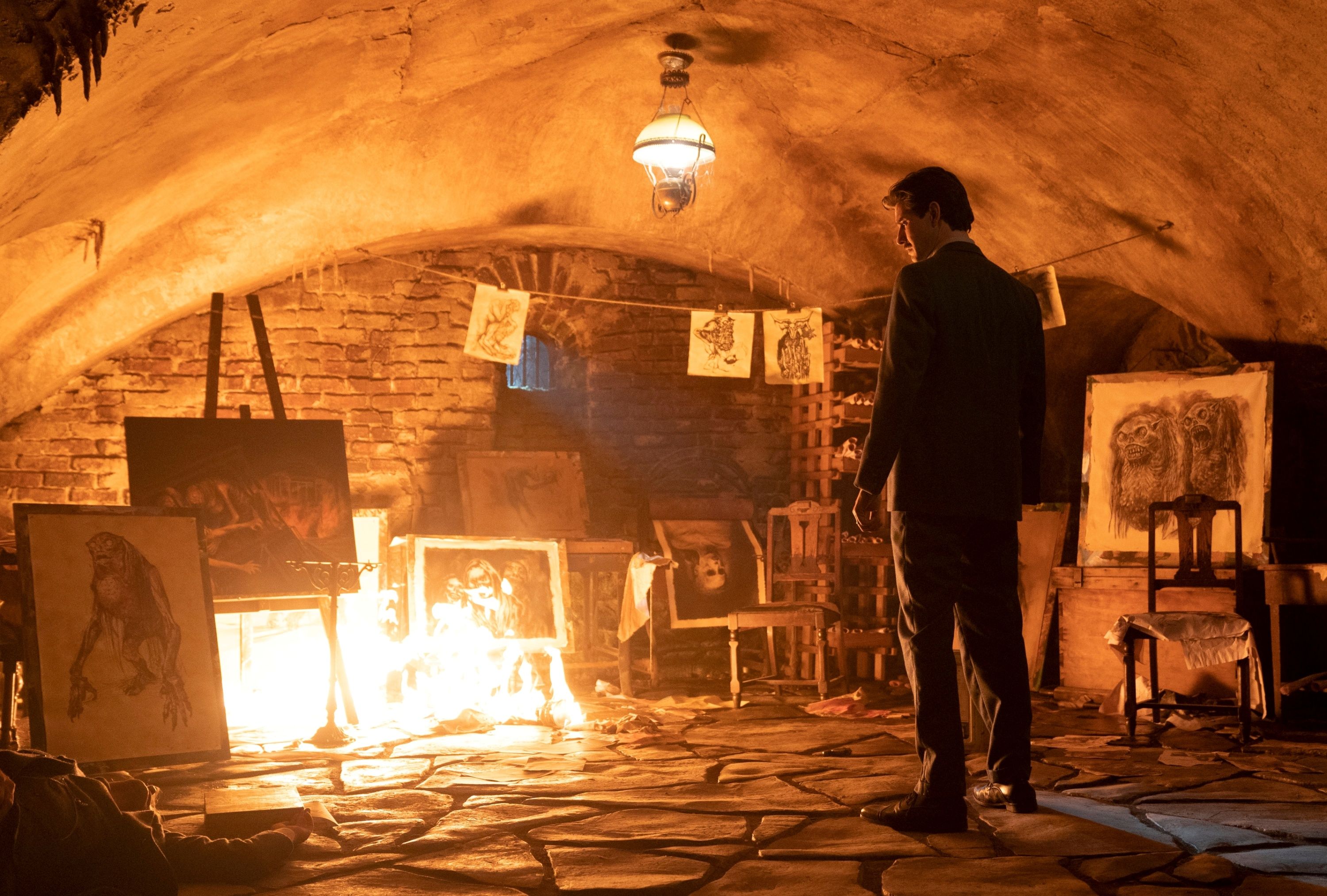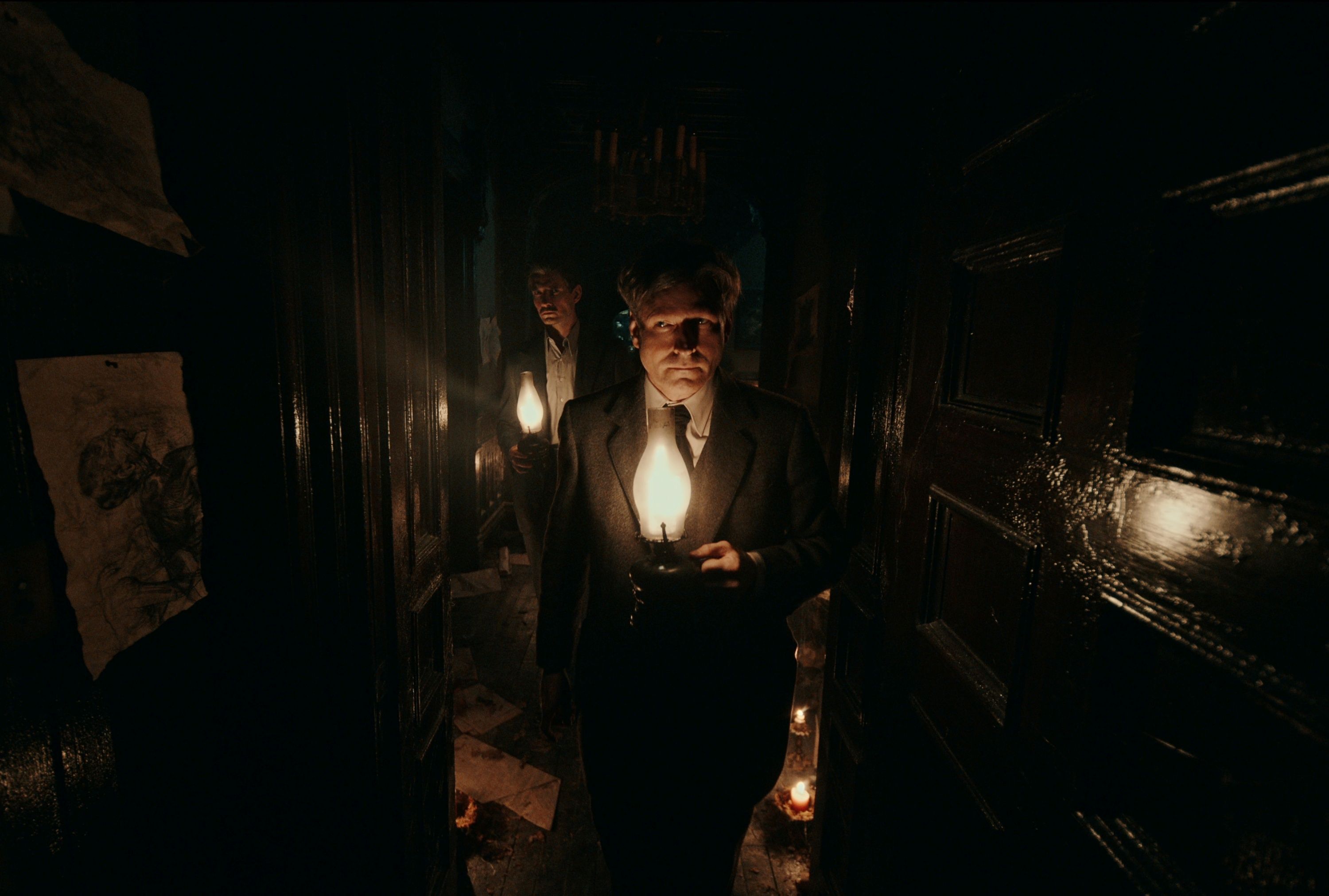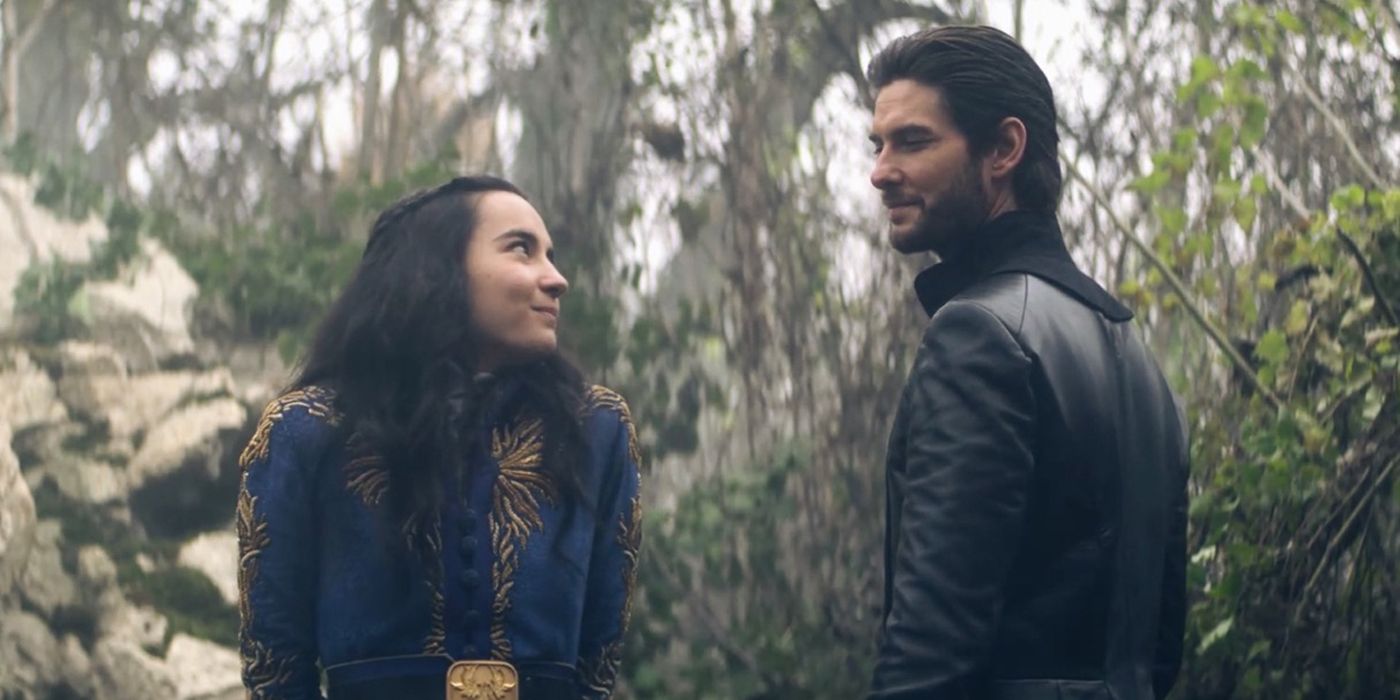[Editor’s note: The following contains major spoilers for the “Pickman’s Model” episode of Cabinet of Curiosities.]
The Netflix anthology series Cabinet of Curiosities is a collection of stories meant to challenge and explore the notions of horror, all curated by the brilliantly mad mind of executive producer Guillermo del Toro. In “Pickman’s Model,” directed by Keith Thomas and written by Lee Patterson from the H.P. Lovecraft short story, starts off in 1909, when promising art student William Thurber (Ben Barnes) has his world turned upside down after experiencing the macabre paintings of the mysterious Richard Pickman (Crispin Glover) and they haunt him to the point of madness.
During this 1-on-1 interview with Drumpe, Barnes talked about what convinced him to break his usual rule of avoiding horror to work on this project, what makes him a fan of Del Toro’s work, why he prefers allegorical and metaphorical to just being creeped out, the power art can have over people, what it was like to shoot one of the most memorable moments, what the director did to ensure that he was as terrified as his character, and what he most enjoyed about working with co-star Glover. He also talked about what fans can look forward to with Season 2 of Shadow and Bone, and what he enjoys about exploring that villainous character.
Drumpe: When this came your way, how was this project presented to you? What were you told about it? What sold you on doing it? How much did they tell you about what the bigger picture of it all was?
BEN BARNES: I got sent the script for this episode and I remember thinking, “It’s a horror thing.” I don’t really do well with horror. I’m very easily creeped out. And it was a period piece playing an artist, which I’ve done about four or five times now. The first play that I ever did, I was playing a period artist in a play that I think had more people in the cast than in the audience, and that was when I was about 20, or something. And I’ve actually just finished another film with Ian McKellen where I play a period artist. I was thinking, “What is it about my face that says 1890s painter?” I can’t draw. But it was honestly this story, even though I was like, “I don’t really want to do another period thing. I don’t want to play an artist, really.” By the end of reading this particular script, and not the story because I read the story later, I’d had such a visceral reaction to it.
And then, I discovered what it was, in terms of it being Guillermo del Toro’s curated anthology, which I just thought was really cool. I was a big Black Mirror fan, and a fan of these anthology things that explore different human themes and reactions and artistic endeavors through one shared genre. I thought was a really cool idea. And I knew some of the directors, that I’d met or worked with, that were going to do the other episodes, so knew it was going to be a classy thing. And then, Guillermo was going to design a lot of it and curate it, and choose the directors and the actors, and design a lot of the monsters himself. He definitely had a hand in each story, bringing it to where it is. I just thought it was a bit of an irresistible combo, really.
Personally, I would love to live in Guillermo del Toro’s cabinet of curiosities because I feel like it would just be endlessly exciting and interesting. Why are you a fan of his? What is it about him, as a filmmaker, storyteller and artist, that you think most stands out?
BARNES: I’ve actually always been a big fan of his, even though I haven’t been a big fan of horror, in general. I believe that we share a similar passion for the duality and grayness and beauty of humanity. His films always show the pain involved in love, or the beauty involved in something disgusting. Those dualities run through a lot of his work. And then, visually, his work is stunning. He’s obviously someone who’s very curious about people and character, and people’s reactivity to whatever it might be, whether that’s something beautiful, something painful, something macabre, or something horrifying. He’s interested in that, and that is definitely interesting to me. It was interesting for me to be playing the character. Having been playing a few baddies, or villains, or psychopaths, or whatever, over the last few years, it was interesting to me to play the guy who’s being affected by this stuff, and to play the guy who is humanity in the story. That was definitely appealing to me.
You talked about being creeped out by horror and not really being a fan of horror, generally. Was there a horror film that you saw that most deeply affected you, that led you to make that decision of not wanting to be around horror?
BARNES: That’s a good question. I do remember watching films like Carrie, Blair Witch, Saw, and some of those things. I probably saw some of those things too young. I definitely don’t like feeling creeped out, so if it’s anything with children whose heads spin around, or things that lurk in the cupboard, and jump scares, I’m not into that. I do love Get Out, and things like that. Anything which is allegorical in nature, I’ll probably enjoy. I love psychological thrillers, like The Game. I don’t mind having my heart go fast, but I don’t feeling like icked out by stuff, which is somewhat ironic, bearing in mind that this episode has a table with someone’s head on it and creepy witches, and all the things that I’m talking about. But I felt like this was more allegorical, in terms of relationship connections, the expression of imagination, reality through art, the blurred lines of that, and the power of art with allegory and metaphor.
Art can have a power over people, whether that’s to inspire, or to horrify, or to make you feel very bleak and empty. That state between waking and dreaming, I often have that on a lot of days. I don’t like dreaming because I often don’t remember them unless they’re horrifying. When I wake up, it often takes me a good few minutes in the morning to shake a dream off and to realize it’s not real. I really hate that feeling, and I’m sure I’m not alone in that. I think watching horror sometimes makes me feel a bit like that, so it puts me in a state of discomfort that I don’t sit easily in. I’ve just realized, in the context of this conversation, that that’s what I don’t like about it.
We also need to talk about the scene where you get your head sawed off. What was your reaction to that, when you read it? Did you get a visual idea of what that might end up being, and then what was it like to actually see what that looked like?
BARNES: I’ve seen the playback of it. I videoed the playback of it, at the time, and you could just hear me going, “Oh, my God,” in the background. It was horrible. But to film, it was a bit like doing a really choreographed love scene, or something. It takes all of what you’d expect to feel in it, out of it because you think you’re waking up in bed, but I was actually half lying off, leaning on this big plastic light box, so that the light could shine back through from underneath. And then, you’ve got this one sheet and a woman in witch prosthetics straddling you. I spent two hours getting the prosthetic neck with a slice across my throat in it. And then, the director was shouting, “Yeah, just saw harder,” to the actress who was playing the witch. It definitely felt very out of body. They were guzzling this gushing syrupy blood through the crack in the prosthetic neck, so I had these tubes down my back, which I was lying on and I could feel it seeping down. I was only wearing a shirt and some underwear, and I could feel the blood filling the underwear, with this warm and sticky horrible feeling. The screaming was just like, “Get me up! Let me out!”
Is it more bizarre and surreal to be the subject of it like that, or to do the scene when he walks in on that dinner with all of the bugs and the human head?
BARNES: Yeah, so you exactly nailed the bit that I hated. I didn’t mind the head sawing bit because it felt very surreal. But when the actor finally shoved his head through the table onto the platform and I was watching it, I actually felt physically sick, just looking at that. I did try to get Keith Thomas, the director, to trick me into various things. I said, “You have my permission to creep me out.” So, I purposefully didn’t go and look at the dinner, all set up, until I had to film it. They were filming it for a while without me, and then I walked in and did my reactions to it, and I was like, “I don’t want to look at it until I’m actually looking at it, so I can feel that.”
On Dorian Gray, I remember that I was doing a scene and I was having difficulty thinking about how I was going to react to a particular moment and piece of news, and the director gave me a really good piece of advice on that. I said, “I don’t know what this feels like.” And he said, “When you listen to it, or when you look at it, key into what is happening in your stomach and feel the blood through your veins and the juices through your stomach. Just key into something inside of you and listen to that and see what that evokes.” I still try to use that.
We also developed a system with the director, where he would have these clapperboards of wood to smack them together in the middle of any scene, to make me jump. He would play creepy music. I foolishly told him that, when I was young, I watched Return to Oz. I remember the protagonist character falling down this well, and these creepy hands grabbing at her. And then, there were the wheelies, who had wheels instead of hands and feet, and this awful screeching music would play and you’d hear the sound of these squeaky wheels when they would arrive. I told the director that I hated that so much, so he would sometimes play that sound over a speaker, in the middle of a scene, like while I was looking at the paintings, for example. Obviously, I was looking at paintings that were gross, but they weren’t affecting, in terms of terrifying you to your soul. So, he would play that sound really loud while I was looking at the paintings, and it almost made my eyes water, I hated it so much.
There’s something that feels almost elusive and mysterious about Crispin Glover, as an actor and as a person. What is he like, as a co-star? How collaborative is he to work with? What was it like to find that dynamic between your characters?
BARNES: Yeah, he absolutely is. He’s mysterious and curious and strange and wonderful. He has such deep passion for storytelling and such deep knowledge about things and he’s so committed to being this thing. I definitely didn’t know him well enough before we started, to find the line between Crispin Glover and this Pickman character. He knew so much about art, and he was so interested in its expression. He found such glee in the macabre elements and in the darkness of it. The director, Keith, was obviously a very big horror fan, and he was finding particular glee and enjoying my discomfort at all of this stuff. When we were rehearsing, we’d look at art together and I would be very easily unsettled. I’d be like, “Guys, why are you still looking at that? It’s so grim.”
The director was thrilled that he’d found actors, by coincidence, that were aligned with the characters, from the start. I was fascinated with everything and ever-hopeful and always looking for the heart in everything. And Crispin, is a truth seeker and looking for representations of things and delving into the grayer sides of people’s imaginations. He’s really curious, but underneath it, is very kind and passionate. He came with so many ideas, all the time, and such a specific idea of how the character would walk and sound and look and interact.
To me, what’s interesting, in the end, is looking at where there is a connection between the characters and where they’re aligned and why, even though this is a man who is clearly destroying his life, knowingly or not, there’s still a pathos and an empathy. That’s what interests me in characters. He was clearly scratching away at digging into the themes, in the same way that Pickman can’t help but dig into the art. He has a bit of that about him, in real life, and it breathes life into the character.
We’ve also gotten to see a tease of Season 2 of Shadow and Bone. What can you say to tease what fans can expect from the second season?
BARNES: I am very aware that Netflix are on this interview.
That’s why I said to tease, and not reveal all the secrets.
BARNES: It’s definitely amped up. I know everyone always says this about a sequel or a second season, but it’s definitely amped up in scale. There are six main characters in the first season, and now, there are essentially about 16. And there are these cleverly intertwined plot lines. People’s agendas and the action is obviously amped up, as is the adventure. I would say, with regard to my character, what I was championing was finding the humanity. He’s quite emblematic of something dark and evil in the books, after the first one, so my mission was to make sure that he’s a real person, suffering the things he’s suffering and committing the sins that he’s committing.
There are the real world ramifications of those things, and the relationships, how they’re made and how they’re broken, whether they can be salvaged, what new connections he can forge to help him along his journey, whilst also representing and not shying away from the fact that this is the villain. Which parts of what he does are comprehensible? Which parts can you not condone? All of that stuff was swimming around in my head while we were shooting. Luckily, we have showrunners that are very kind and collaborative, in terms of my input on that character. I feel quite a deep connection to what it ended up being, even though it’s fantasy and even though it’s a villain. I felt like I could take ownership of a lot of where it goes, so I’m very keen to see it. I’ve seen very little, but what I have seen does look very cool.
Cabinet of Curiosities is available to stream at Netflix.




